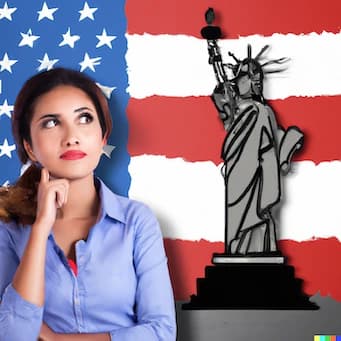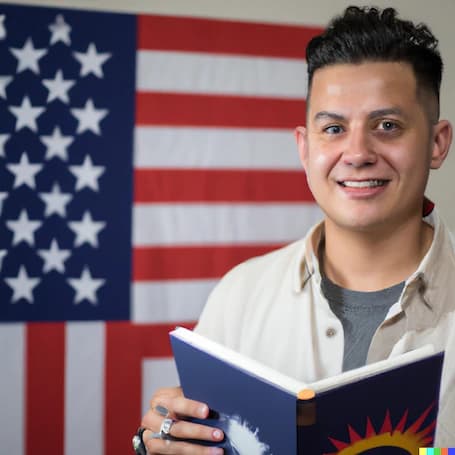Total Cost to Apply USA Study Visa for Nepali Students
Table of Contents
- Cost of Each Step Before US Student Visa Approval
- Cost Summary Before Visa Approval
- Cost of Each Step After US Student Visa Approval
- Cost Summary After Visa Approval
- Frequently Asked Questions
- Conclusion

Key Highlights
- Obtaining a USA study visa involves taking English proficiency tests such as IELTS, PTE, TOEFL, or Duolingo.
- You need to prepare for standardized tests like GRE, GMAT, SAT, or ACT, especially if you’re seeking scholarships.
- Application and SEVIS fees are essential costs before the visa interview, along with presenting a bank statement showing sufficient funds.
- Minimum cost before US visa approval ranges from NPR 1,15,400 to NPR 1,31,100, and maximum ranges from NPR 1,44,472 to NPR 1,54,700.
Many Nepali students dream of pursuing their higher education in the United States. However, the process of obtaining a USA study visa for Nepali students is not straight forward. In this blog, you'll find detailed information about what you need to prepare for and how much each step costs in Nepal.
You can also visit our other blogs for the overall guidelines to unfold the chapter of you to study in the US.
Cost of Each Step Before US Student Visa Approval
1. English Proficiency Test:
Most universities in the US require English proficiency, so you have to take English Profiency tests. This include ILETS, PTE, TOEFL, or Duolingo and you can take any one of them. Lets understand each test and how much it cost in Nepal.
-
ILETS: The ILETS on Computer (Academic and General Training) costs in Nepal is NPR. 27,100. Nepali Students looking to take the ILETS exam are required to pay an ILETS registration fee of NPR 27,100 every time they book their ILETS exam.
-
PTE: PTE exam costs in Nepal is NPR 25,000. If a candidate books his PTE exam within 48 hours (about 2 days) of the test date, they must pay the PTE late booking fee.
-
TOEFL: TOEFL exam cost in Nepal is NPR 26,000. If Nepali Students want to have other extra services, they need to pay for that.
-
Duolingo: Duolingo Test takes less than 45 minutes and includes a proficiency score, video interview, and writing sample. Duolingo exam costs in Nepal is NPR 6,500.
| English Proficiency Test | Cost (NPR) |
|---|---|
| IELTS | 27,100 |
| PTE | 25,000 |
| TOEFL | 26,000 |
| Duolingo | 6,500 |
ILETS and TOEFL exam are the most common test and widely accepted by the universities and colleges of US. Also, some institutions have specific requirements of ILETS, TOEFL, or SAT.
2. Standarized Test for Scholarship: (Optional)
This includes GRE, SAT, ACT:
-
SAT: The total SAT Fee in Nepal is NPR 13,800. This price may vary if the candidates apply for the late registration, change their testing center, or if the registration is cancelled.
-
ACT: The cost of ACT test is $150 (NPR 20,000) without the writing section and including the writing section, it will cost around $166.50 (NPR 22,272).
-
GRE: GRE Exam Fee in Nepal is approximately NPR 29,500. To qualify for the GRE category, your score must be between 150 and 160 in the GRE Verbal.
Students applying for Sciences, Humanities, Social Sciences, Business, and other disciplines, take GRE.
-
GMAT: GMAT Exam can be delivered online or at exam center. There is price variation depending on your preference. If you choose to deliver online, then it will cost around USD 275 or if you wish to submit the test from test center then it will cost around USD 250.
Students applying for MBA program, take GMAT. GMAT is specifically focused on assessing skills relevant to business and management education.
| Standardized Test | Cost (NPR) |
|---|---|
| GRE | 29,500 |
| GMAT | 32,500 |
| SAT | 13,800 |
| ACT | 22,272 |
Note: All these standardized tests are taken to test your Verbal Reasoning, Quantitative Reasoning, and Analytical Writing. Also, SAT and ACT test are not designed for the specific undergraduate/ graduate program.
3. Application Fee:
Applying Nepali Students should pay $50 - $150 (approximately 6,000 - 25,000) as an application fee depending on the university. Some universities waive application fees, so you don’t need to pay. It also depends on how many universities you apply to because the more universities you apply to the more application fee you might have to pay.
4. I-20 Fees:
Most universities do not charge for the I-20. They will be sending your I-20 in your email and you can print and sign it to use it in the visa interview. If you are planning to get the I-20 in hard copy then, you must pay for shipping (which is around $60 - NPR 8,100).
5. Bank Statement:
The requirements for the bank statement usually include information on the applicant's financial capacity, such as sufficient funds to cover tuition, living expenses, and other associated costs.
For an F1 visa, you must have a minimum balance of $20,000 (NPR 27,00,000). You can show this bank balance as a 1-day bank balance as well. You can show this bank statement from any of the bank in Nepal.
6. SEVIS Payment:
SEVIS stands for the Student and Exchange Visitor Information System which is managed by the U.S. government to track and monitor F (student) and J (exchange the visitor).
For SEVIS payment, applicants need to pay $350 (approx. NPR 47,000) through any bank from Nepal. This payment is valid for 1 year. It means, in case if you want to switch the program, reinstatement, changes in your dependent status then you don’t have to pay till the 1-year validation.
7. Interview Fee Payment:
For Interview Fee Payment, applicants need to pay $185 (approx. NPR 25,000) at Nepal Investment Bank. This amount is paid during the scheduling of Interview date as per the candidate convenience.
It's crucial to thoroughly prepare for the interview, be ready to provide clear and concise answers, and bring all required documentation.
Cost Summary Before Visa Approval
From 1. to 7., we have discussed about the cost before US visa approval. The table below demonstrates essential costs like application fees and SEVIS payment, providing a clear picture of the expenses Nepali students need to cover before visa approval, excluding bank statement proof.
| Cost Item | Cost (NPR) |
|---|---|
| Application Fee | 15,000 |
| I-20 Fees | 8,100 |
| SEVIS Payment | 47,000 |
| Interview Fee Payment | 25,000 |
| Total Other Costs | 95,100 |
Bank Statement is excluded from other costs because you just need to show the amount in the bank.
Minimum Cost Breakdown:
Here, we calculate the lowest possible expenses for visa application, considering the cheapest options for English proficiency and standardized tests, along with other mandatory fees.
| Cost Item | Bachelor (NPR) | Masters (NPR) |
|---|---|---|
| Cheapest English Test | 6,500 (Duolingo) | 6,500 (Duolingo) |
| Cheapest Standardized Test | 13,800 (SAT) | 29,500 (GRE) |
| Total Other Costs | 95,100 | 95,100 |
| Total Minimum Cost | 1,15,400 | 1,31,100 |
Maximum Cost Breakdown
This section shows the highest potential costs, factoring in the most expensive English test (IELTS) and standardized tests (ACT for undergraduates-bachelor, GMAT for graduates-masters), plus all other necessary fees.
| Cost Item | Bachelor (NPR) | Masters (NPR) |
|---|---|---|
| Most Expensive English Test | 27,100 (IELTS) | 27,100 (IELTS) |
| Most Expensive Standardized Test | 22,272 (ACT) | 32,500 (GMAT) |
| Total Other Costs | 95,100 | 95,100 |
| Total Maximum Cost | 1,44,472 | 1,54,700 |
Cost of Each Step After US Student Visa Approval
8. Medical Checkup:
Medical checkup for student cost around 162 USD. (US requires vaccination for diseases such as Meningitis, Measels, Hepatitis which can be done through any Nepali hospitals). You can find the list of vaccination for diseases from your univeristy.
Any other fees, including X-Ray and blood test fees, must be paid directly to the examining physician at the IOM exchange rate. Extra fees and extra checkups are totally optional.
9. Orientation Fee:
Some universities charge an orientation fee at the beginning of the session to cover overall orientation expenses. You can pay for this online. This fee can be varied according to universities and, some universities don’t ask for the orientation fee.
The average cost for orientation fee ranges from $50 to $300 (approx. NPR 6,500 to 40,000).
10. Average cost of attendance for universities in US:
Most Nepali students choose affordable US universities so the cost can be managable. There are few Nepali students with strong academic credentials who get full scholarship in the US university and study for Free.
- For a Bachelor in US, it will cost around 10,000 – 35,000 USD/year
- For a Masters in US, it will cost around 15,000 - 40,000 USD/year.
This estimated cost may vary according to the university. Especially for international students, there might be some changes in the university yearly cost. Usually, most of the universities charge more costs for international students.
11. Shopping:
Nepali Students spent like NPR 40,000 to 1,00,000 to buy clothes, electronic devices, initial settling expenses, travel expenses, food and groceries.
This shopping cost totally depends on you.
12. Health Insurance:
The average cost of health insurance for international students in the US ranged from $500 to $2,000 per year (approximately NPR 65,000 to 2,50,000).
Some universities also have their own policy about Health Insurance. We advised you to check the college/universities policy before you applied for your health insurance. In case, if there is no such health insurance policy in your university then you might have to contact the Insurance Company as per your convenience.
13. Flight Ticket and Dollar Exchange:
Flight Ticket expenses cost up to NPR 1,50,000. When you're in the U.S., you'll need dollars to make everyday transactions. We suggest you exchange at least $1000 to $1500. So, in total you may require NPR 3,00,000.
Cost Summary After Visa Approval:
| Education Level | Minimum Cost (NPR) | Maximum Cost (NPR) |
|---|---|---|
| Bachelor | 13,50,000 | 32,40,000 |
| Masters | 16,20,000 | 40,50,000 |
| Cost Item | Minimum Cost (NPR) | Maximum Cost (NPR) |
|---|---|---|
| Medical Checkup | 21,870 | 21,870 |
| Orientation Fee | 6,750 | 40,500 |
| Shopping | 40,000 | 1,00,000 |
| Health Insurance | 67,500 | 2,70,000 |
| Flight Ticket and Dollar Exchange | 3,00,000 | 3,00,000 |
| Total Excluding University | 4,36,120 | 7,32,370 |
Minimum and Maximum Cost Table for Nepali students Studying in the US for 1 year.
| Education Level | Minimum Cost (NPR) | Maximum Cost (NPR) |
|---|---|---|
| Bachelor | 17,86,120 | 39,72,370 |
| Masters | 20,56,120 | 47,82,370 |
Frequently Asked Questions
-
How do I apply for a U.S. student visa?
You can apply for a U.S. student visa by completing the online visa application form (DS-160), paying the visa application fee, scheduling a visa interview, and attending the interview at the U.S. embassy or consulate in Nepal.
-
Are there scholarships available for Nepali students studying in the U.S.?
Yes, many U.S. universities offer scholarships and financial aid to international students. Additionally, there are external scholarship programs and grants that Nepali students can explore.
-
What should I do if I face challenges or emergencies while in the U.S.?
Most universities have international student support services. Reach out to your university's international student office for assistance. In emergencies, contact local authorities or emergency services.
-
What are the tuition fees for Nepali students in U.S. universities?
Tuition fees vary widely among universities and programs. The average tuition fees for Nepali students in the US university is approximately $10,000 to $30,000 USD/per year.
-
What additional expenses should I consider beyond tuition fees?
Living expenses, accommodation, health insurance, textbooks, and personal expenses are some additional costs. It's essential to budget for these to get a realistic estimate.
-
Can Nepali students work part-time while studying in the U.S.?
Typically, international students are allowed to work part-time on campus. Nepali students can work upto 20 hours per week in the university. However, there are regulations, and it's important to be aware of them to maintain legal status.
-
Are there any financial aid options for Nepali students?
Some universities provide financial aid packages, and there are also private loans available for international students. Most Nepali students in the US receive financial aid in the form of scholarships based on their academic performance and test scores.
-
How can I estimate the total cost of living in the U.S.?
Research the costs of accommodation, food, transportation, and other living expenses in the city where you plan to study. Universities often provide estimates.
Conclusion:
For Nepali students dreaming of studying in the United States, understanding the financial aspects of the visa process and life in the U.S. is crucial. From English proficiency tests to medical checkups, each step involves specific costs. This blog has detailed these expenses, providing both minimum and maximum estimates for a clearer financial picture. Whether it's for bachelor's or master's studies, students can anticipate the costs of tuition, living expenses, health insurance, and more, ensuring they are fully prepared for their academic journey abroad. Remember, thorough preparation and awareness of these expenses are key to a smooth and successful transition to studying in the U.S.





